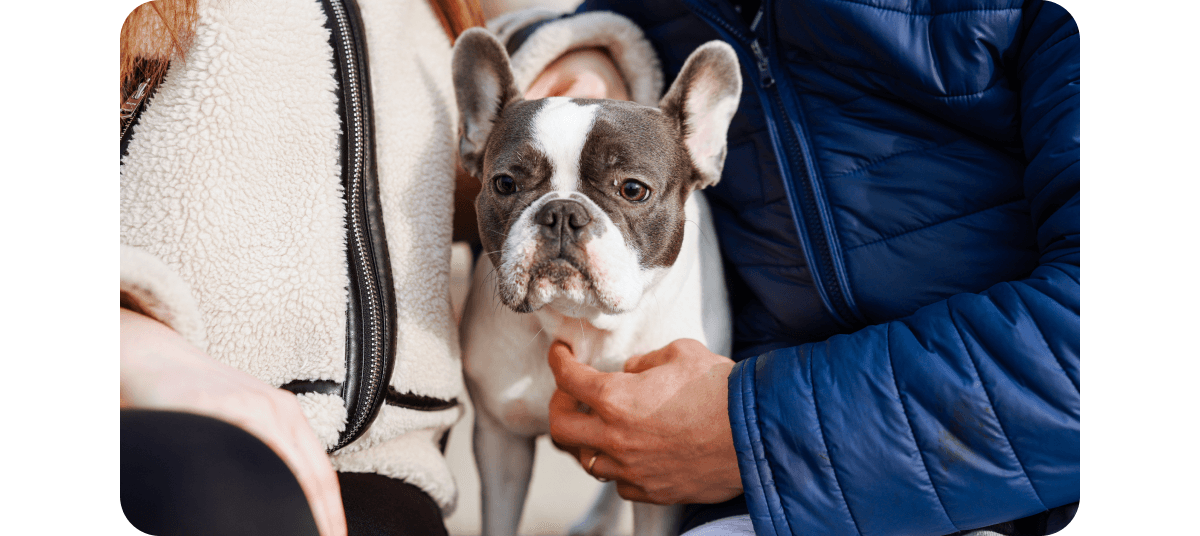Everything you need to know about Patterdale Terriers

Summary
Small dog, big energy. Patterdales aren't a breed but a type, made up of a mix of terriers.
Key Stats
Height
25-38cm
Weight
4- 6kg
Size
Small to medium
Lifespan
12-15 years
Coat
short, broken, or wiry
Exercise
1-2 hours daily
Grooming
weekly
Temper
Smart, energetic, independant
Breed history
The Patterdale Terrier gets its name from the village of Patterdale in the Lake District where they originated. They aren't a formally recognised breed, but are a type of dog. So there's no breed standard for them, so any dog with the right appearance, mix of breeds, and working background could be a Patterdale.
They're a mix working terrier breeds. The aim was to create a hardy little dog that could control pests like rats and foxes.
Joe Bowman, Master of the Ullswater Hunt in 1873, is credited with early development of the Patterdale type. He had been breeding Border Terriers but wanted to create a more versatile terrier. Another huntsman, Cyril Breay, further developed them. It's believed that all Patterdale's can trace their ancestry back to his dogs.

Appearance
These little dogs are sturdy and tough thanks to their need to hunt in the rugged Lake District. Patterdales can vary a lot in looks because there's no standard appearance, and they're a mix of lots of different breeds.
Generally, they’re small to medium sized dogs, with a compact and muscular body. Their head can be quite broad and rounded, with wide jaws. Their triangular ears are relatively small for their head, and tip forward tightly over their face.They have three coat types, smooth, broken, and rough. Smooth coats are short, smooth, and glossy. Broken coats are course with longer fur or "whiskers" around their muzzle. And rough coats are long and wiry.
Patterdale Terrier colours
There aren't many Patterdale Terrier colours. Traditionally, they were a solid black colour. But over time small white markings on the chest or feet have become more common.Because they're not a recognised breed there is no standard appearance, including colours. But common Patterdale Terrier colours are:
- Black
- Black and white
- Chocolate
- Red
- Chocolate and red
- Brindle
- Tan
Any other colours or larger patches of white are allowed, and might be from having Jack Russell Terrier in their mix.
Patterdale Terrier temperament
The typical Paterdale Terrier temperament is fearless, adventurous and energetic. They're brimming with energy and enthusiasm, and can make ideal pets for those seeking a lively dog that enjoys plenty of playtime and activities.
But like most terriers, they generally prefer the company of humans over other critters. Given they were bred to hunt foxes and small animals, they have a strong prey drive. But early socialisation can help them learn to get along with other pets and they often form strong bonds with them.
A Patterdale may be challenging for a first-time pet owner. Their intelligence, independence, and prey drive can make them difficult to manage if they aren't properly stimulated and socialised.However, if you have an active outdoor lifestyle and thoroughly researched their needs, a Patterdale could be the perfect pet for you.
How much exercise does a Patterdale Terrier need?
Patterdale Terriers will need at least an hour of exercise a day, ideally two. Split this into at least two walks a day, and some time towards games, training, or other forms of enrichment.
It's important to remember that working dogs like Patterdale Terriers thrive on activity and tasks. A bored dog can become "mischievous", as they try to find things to entertain themselves. Positive reinforcement training will help teach them what behaviour you expect, and plenty of exercise and mental stimulation will help prevent boredom.
How to groom a Patterdale Terrier
How to groom a Patterdale Terrier will depend on their coat type. Smooth-coated dogs have the least grooming needs. Just brush them once a week. Broken coats need a brush once or twice a week, and may need their longer areas of hair hand-stripped in the summer to keep them cool. Rough coats will need hand stripping in the summer.
No matter their coat type, they should be bathed every few weeks, and their nails checked and trimmed about once a month. Check their ears and skin regularly for any injuries, infections, or funny smells. And if there is anything unusual, get a vet. They can advise on how to trim their nails and clean their ears too.
And like all dogs, they need regular tooth brushing to keep their teeth and gums healthy. A vet can help you plan how to keep them clean, but brushing a few times a week is ideal.
Common Patterdale Terrier health problems
Allergies
Like many terriers, allergies are a common Patterdale health problem. It causes itchy skin, known as "atopy", often on the feet, belly, skin folds, and ears. Common signs include paw licking, face rubbing, and frequent ear infections. Symptoms usually at one to three years old and may worsen with time. There are several treatment options to help manage the condition.
Hypothyroidism
Hypothyroidism is when the thyroid gland doesn't produce enough hormones. This can cause weight gain, lethargy, and skin issues. Regular vet visits and spotting symptoms early can help catch it and manage symptoms with medication.
Patellar Luxation
This is where the kneecap (patella) dislocates and can cause limping or lameness. It affects many dog breeds, especially small to medium-sized dogs. But it's not as common in Patterdale Terriers as other small breeds like Chihuahuas or Yorkshire Terriers.
Eye problems
Patterdales, being a terrier, may be prone to lens luxation. It's painful and can cause inflammation and cloudiness in the eye and increases the risk of glaucoma and blindness. Early diagnosis and treatment are vital to manage this condition. You must call your vet right away if you're worried about your pet's eyes.
Hip problems
They can develop Legg-Calvé-Perthes Disease, where the hip joint breaks down, causing pain and lameness. This condition is common among Terriers, so isn't specific to Patterdales.
Frequently asked questions
When are Patterdale Terriers fully grown?
Patterdale Terriers are generally fully grown by 14 months. Although they'll probably reach their adult size before they're 12 months old, it takes a few months for them to develop muscle and reach their adult weight. An adult Patterdale Terrier's size is 25 to 38cm tall, and weighs 4 to 6kg. Like most dogs, males tend to be taller and heavier than females.
How long do Patterdale Terriers live?
The typical Patterdale Terrier lifespan is 12 to 15 years. Which is slightly longer than the overall average life expectancy for dogs. Maintaining a healthy lifestyle, including regular exercise and a balanced diet, will increase your pup’s chance of a longer and healthier life.
Are Patterdale Terriers easy to train?
Patterdale Terriers aren’t the easiest dogs to train. Because of their working background they are independent and bold, so can seem "stubborn". But they're also smart and can be eager to learn. So with positive reinforcement, patience, and consistency, you should be able to teach your pup everything you need.
Are Patterdale Terriers aggressive?
Patterdale Terriers are known for being bold, but not aggressive. Although they do have a high prey drive, so they're not great with small furries. But with good socialisation and training from a young age, they might grow up to be friendly dogs.
If your dog shows signs of aggression, please contact your vet immediately for further advice. Keep them separated from family members, children, or other pets. If you are bitten, seek medical attention as soon as possible.
Do Patterdale Terriers shed?
Yes, Patterdale Terriers shed. They don't shed a huge amount though, and their short, dense coats don't need too much grooming. Brushing and hand-stripping their fur can help remove any dead hair.
Are Patterdale Terriers hypoallergenic?
No, Patterdale Terriers are not hypoallergenic. They can still shed some dander and fur, but they aren't droolers. Plus, no dog breed is completely hypoallergenic.Please consult your GP or the NHS for further advice about getting a dog if you have allergies.
Jump to
Why isn’t my cat using the litter tray?

Why isn’t my cat using the litter tray?
By Rachel Rodgers MSc, Head of Training at Napo Pet Insurance
Blog
10 things you need to know about Frenchies

10 things you need to know about Frenchies
By Rachel Rodgers MSc, Head of Training at Napo Pet Insurance
Blog
Are Frenchies aggressive or stubborn?

Are Frenchies aggressive or stubborn?
By Rachel Rodgers MSc, Head of Training at Napo Pet Insurance
Blog